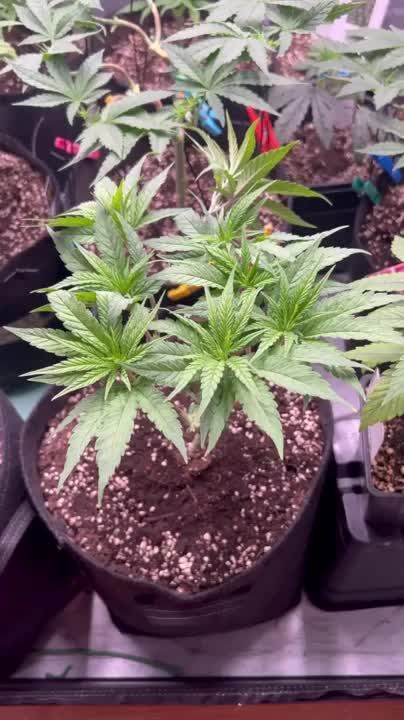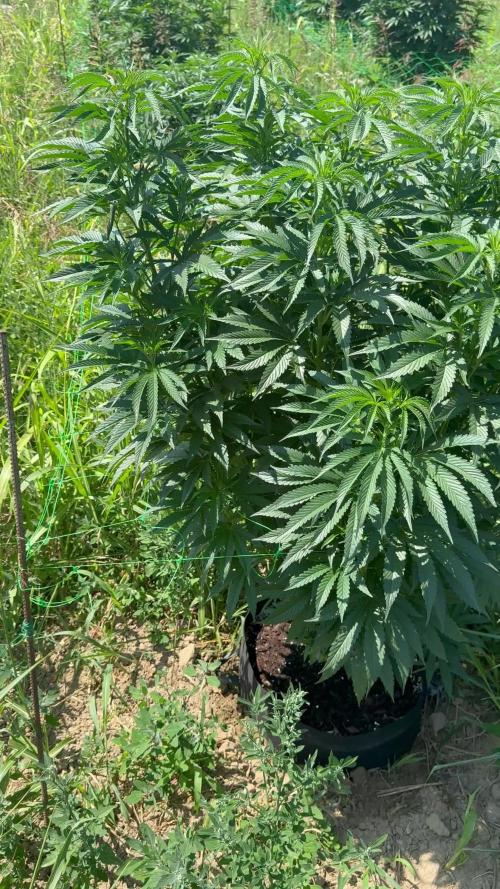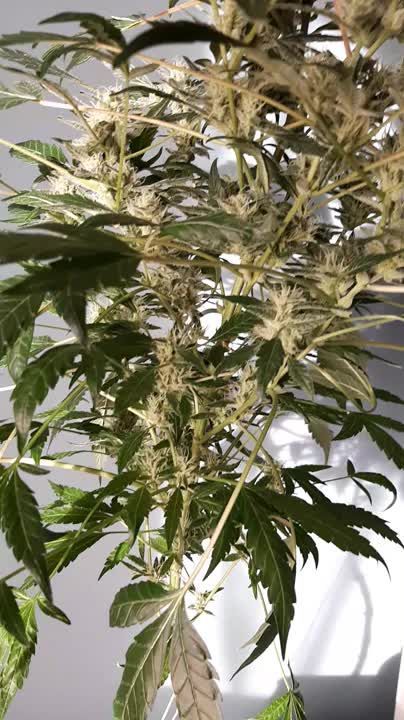By continuing to use the website or clicking Accept you consent to our cookies and personal data policy and confirm that you are at least 18 year old. For details please see Privacy Policy and Terms
Accept
Likes
Comments
Share


@Comfrey
Follow
Growing well. Some insects hovering around. Soil is moist so I watered only because I wanted to give some field horsetail.
Likes
64
Share


@Chucky324
Follow
Hello.
I've harvested the Mega Mouth. WOW!!! I'm very impressed with this strain. Over 1.5 k for 5 plants. and it was finished by Aug 20 with the tents help.
I'm trying some new (for me) categories to add to my report.
Plant Stretch (PS) 1 to 5- 1 is hardly any stretch.
Bud Mutation (BM) 1 to 5- 1 is a beautiful normal bud- 5 is big weird growths like foxtails.
Trim- How easy or hard it was to trim up 1- you blow on the branch and hang it up. 5- Is very hard to trim takes a long time.
About- Best guess on the THC % (I've been smoking a long time)
Resin- 1 is super slippery 5- is very sticky like Gorilla Glue.
Size of Buds (SOB) 1- is very small 5- is the biggest buds
Dense- 1- is the lightest or fluffiest 5- is the rock hard buds your bud buster has trouble busting up.
Plant #1 Wet Trim 1647 g
PS. 3.5
BM 3.5
Trim 4
About 21%
Resin 4
SoB 4
Dense 4
Finished Dry Weight 289.5 g or 10.33 oz.
Plant #2 Wet trim 1606 g
PS 3,5
BM 3.9
Trim 4
About 22%
Resin 3
SoB 4.7
Dense 4.3
Finished Dry Weight- 302 g or 10.78 oz.
Plant #3 Wet Trim 1635 g
PS 3.7
BM 3
Trim 2.8
About 20%
Resin 2.8
SoB 3.7
Dense 4.5
Finished Dry Weight- 314 g or 11.21 oz.
Plant #4 Wet Trim 1753 g
PS 2.5
BM 2.5
Trim 3
About 22%
Resin 4 Falls off easily- Clumpy
Dense 2.5
Final Dry Weight- 343.5 g or 12.26 oz.
Plant #5- Wet Trim 1787 g
PS 3.5
BM 3.7
Trim 3
About 24%
Resin 2.5
Dense 2.5
Finished Dry Weight- 355.5 g or 12.69 oz.
The taste is sweet and smooth to go down with a nice balanced buzz. There was some pests around. I found thrips damage in veg and got some Spinosad to take care of that. Saw some fungus gnats around but they didn't do much damage. Easy to grow and trim. This is a recommended strain.
Chuck.
Likes
8
Share


@I_Identify_As_A_Dan
Follow
Week 6 for Ztrawberry by greenhouseseedco
End of week 6 for this cultivar, shes currently at 8 mains waiting to be stretched out around the pot... still considering going for 16pots but her new nodes aren't symmetrical so it would be more difficult to do so.
Only got fed water once this week.
Likes
17
Share


@Gasoliere_sama
Follow
The smell is very good. A good weight if I consider that I have made some mistakes with Calmag.
Likes
16
Share


@LivingOrganics
Follow
Week 14, Flower
(Day 57 12/12)
Riding straight into week 8 now so this is when I expect her to put most of her weight on which is hard to believe considering colars are already falling over.
Still filling the res up and just letting her do her thing. Smells are incredible! She is definitely going 10weeks minimum not a orange trichome in site and fresh flowers popping up.
No more signs of bananas and she is happy I put her into slightly more dark and raised the lights a little as well. Now it's just ride it out for the next couple weeks.
Likes
13
Share


@Radagast_
Follow
23.07.
White Runtz
Day 85#
Yesterday was the end of the twelfth week for the plant.
She was fed this morning.
The heat has started fiercely again, and I, the lazy one, haven't put up the shade net yet...
Stay High and Keep Growing!
Likes
7
Share


@CanadianFillmore
Follow
Great smoke, very smooth, no coughing! I smoke mostly joints, some blunts and occasionally a bong. I find the high very sativa like, it's mentally calming, I'm more focused and energetic. No problems sleeping after several joints either.
Processing
Likes
39
Share


@DjDaveAtHome
Follow
Removed damaged leaves from DinaMed CBD Plus (DC+). Refreshed res'. Using Alaskan Organic Bloom to control my PH till the massive rises stop. Close now. Put another air line and stone into both buckets. Seems to help. Adding Microbe tea (formula below) as well as Hygrozyme and Advanced Nutrients Tarantula. Adding Alaskan Bloom not only helps the PH but feeds the microbes. Brewing tea also helps chelation of the metal micro nutrients as well as converting Humic acid to Fulvic acid which is easier for the plant to uptake.
Dinamed Plus from Dinafem Seeds (1) and Blueberry Headband (1)from Humboldt Seeds.
https://www.dinafem.org/en/dinamed-cbd-plus/
https://www.humboldtseeds.net/en/blueberry-headband/
Lighting
https://www.horticulturelightinggroup.ca/products/260w-qb-v2-led-kit
DWC Nutients
https://generalhydroponics.com/floraseries
FloraGro 1 ml/l
FloraBloom .5 ml/l
FloraMicro 1 ml/l
Diamond Nectar: N/A
https://generalhydroponics.com/diamond-nectar
Cal Mag: 2 ml/l
https://generalhydroponics.com/calimagic
SuperThrive: .5 ml/l
https://superthrive.com/
https://hylineproducts.com/products/hygrozyme/#one
Grozyme: 2.5 ml/ltr
Tarantula
https://www.advancednutrients.com/products/tarantula/
Epsom salts
Root Rot Tea
8 liters RO water
5 ml (1 tsp) organic sulphur free molasses
5 ml Alaskan Organic grow fertilizer (or something comparable)
5 ml Alaskan bloom fertilizer (or something comparable)
5 ml Seaweed or kelp fertilizer
Handful of composted horse pucky
Worm castings, sea soil, Gaia General Purpose and Bat Guano Phosphate optional
* add after brewing
2-4 ml Advanced Nutrients Tarantula
Likes
209
Share


@BioBuds
Follow
It was finally time to harvest her, what good times we had with her. Amazed with how beautiful this plant is, how easy to manage and train and how rewarding Orange Hill Special is.
So we said our thanks and goodbye, thanked her for all the joy she gave while growing her. I realize more and more how I love growing them even more than the end-product.
It takes my mind of all going on for a while, in my miniature jungle world in the attic.
Im sure all of you just sometimes sit there and watch them, in wonder, dreaming away with a good buzz on, watching them wave in the wind of the fans.
So with a heavy hart I apologize, play them their last music, sit with them and feel them and smell them, watch the glistening of the cristals.
In the end we had 209 gram dried Orange Hill Special, I will know the total of the grow, in a few days, since the final big whopper still has to dry: my XtraKush, be sure to check the harvest of that one *in couple of days) and see a one-dollar seed outperform two 10 dollar seeds.
I probably go over 500 grams for the total grow, which would be 1.6 grams per watt. Big success!
Consider an SP-3000 for your next light, you won't be disappointed! Check www.mars-hydro.com for the latest discounts!
Thank you @MarsHydroLED for letting us try out your light, it made this successful grow possible!
Greetings and all the best! Thank you to our friends here, our followers and the whole Growing Diaries community for just being there.
Big Hug,
Sunshine and BioBuds
Likes
42
Share


@rhodes68
Follow
Chew Mee - 1390 grams wet - 221 grams dry
Dink - 1040 grams wet - in dry- dry yield 182 grams
Likes
26
Share


@Highgrade_Harvests
Follow
End of week 7 of flower has come. All 3 plants are doing great. The one tall one has gotten so big it fell over and I had to tie up a bunch of colas. They all smell really good but each one has a slightly different scent to it. The runt is small but has a lot of colas. The one in between I think has the best structure out of the bunch. Almost harvest time.
Likes
4
Share


@Ryno1990
Follow
All these beautiful girls are going thre flush now getting ready to harvest up they are all very resiny an covered in trichromes all the nugs are nice an dense an are smelling amazing can't wait to be able to dry an start curing them
Likes
13
Share


@quigley
Follow
Had a busy week and have lost track of exactly what happened on which day.
Early in the week I noticed slowing growth and so checked runoff EC which was drastically into the negative, indicating the plants were taking in more nutrients than I was providing them. I have been increasing inflow EC all week. This has caused MASSIVE growth. I continued to adjust the LST points as well as commencing some defoliation after first pestils showed. This is the only real sign of flowering on either of the two plants thus far which is great as it will see these plants continue to get larger and larger. At nearly full concentration of suggested nutrients, I am quite surprised the plants are taking in as much as they are. Noticed the Blue Diesel is growing 9 pronged fan leaves which is a sign of great health.
I am really enjoying growing with coco coir. It is so easy to manage though it does involve daily work. There is very little guess work and so long as you are good with plants already, it seems like the coir offers "the best of both worlds" between soil and full hydro. I do intend on starting a soil grow in the next few weeks to compare. Stay tuned!
Processing
Likes
18
Share


@Bread_n_Buds
Follow
What a trip with these Monster Zkittlez. We have almost reached the end, going through many fears we are reaching excellent results for real. I have three young ladies planted one before and two more after 10 days to test the right vegetative times. The first was worked with very aggressive LST and now I dominate many weeks of flowering is fantastic. They are putting all of them very much but they are filling up really well except one that seems lost and is not bad. In fact, the two smaller ones were also low stressed and treated with an aggressive pruning to keep only a big main cola and something lateral. One has filled very well another is filling less and very slowly but still with dignity, I gave it up for lost but even the ugliest is not bad. The big has some scary banana. The frozen speaks for itself sugar dripping from everywhere early harverst next weekend
Likes
21
Share


@helpmamagrow
Follow
Wanted to wait til they were healthier to flip but ended up just flipping anyway since I was running out of height space. Will probably defoliate more up until week 5 and then just let her do her thing after that!


































